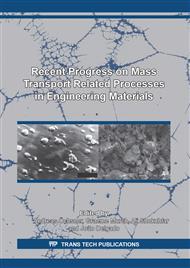[1]
Shih-Hang Chang, Bor-Yann Chen, Yung-Chih Lin, Toxicity assessment of three-component Fe–Cr–Ni biomedical materials using an augmented simplex design, Materials Science and Engineering C 32 (2012) 1893–1896.
DOI: 10.1016/j.msec.2012.05.008
Google Scholar
[2]
Assem A. Sultan, MD, William A. Cantrell, BS, Anton Khlopas, MD, Ryan J. Berger, MD, Nipun Sodhi, BA, Robert M. Molloy, MD, Viktor E. Krebs, MD, *, Michael A. Mont, MD, Evidence-Based Management of Trunnionosis in Metal-on-Polyethylene Total Hip Arthroplasty: A Systematic Review,, J. Arthroplasty, 33 (2018) 3343-3353.
DOI: 10.1016/j.arth.2018.05.035
Google Scholar
[3]
Chalmers BP, Perry KI, Taunton MJ, Mabry TM, Abdel MP. Diagnosis of adverse local tissue reactions following metal-on-metal hip arthroplasty. Curr. Rev. Musculoskelet Med., 9 (2016) 67-74.
DOI: 10.1007/s12178-016-9321-3
Google Scholar
[4]
Saravanan M., Devaraju A, Venkateshwaran N., Krishnakumari A., Saarvesh J., A review on recent progress in coatings on AISI austenitic stainless Steel, Mater. Today Proceedings (ICAFM-2017) 5 (2018) 14392–14396.
DOI: 10.1016/j.matpr.2018.03.024
Google Scholar
[5]
E.J. Sutow, S.R. Pollack, in: D.F. William (Ed.), Biocompatibility of Clinical Implant Materials, I, CRC Press, Boca Raton, FL, 1981, p.45–48.
Google Scholar
[6]
Y.C. Tang, S. Katsuma, S. Fujimoto, S. Hiromoto, Acta Biomater. 2 (2006) 709–715.
Google Scholar
[7]
Y. Okazaki, E. Gotoh, Corros. Sci. 50 (2008) 3429–3438.
Google Scholar
[8]
I. Gurappa, Surf. Coat. Technol. 161 (2002) 70–78.
Google Scholar
[9]
M.A. Costa, M.H. Fernandes, J. Mater. Sci. Mater. Med. 11 (2000) 141–153.
Google Scholar
[10]
Enrique Hernández-Sánchez, Julio C. Velázquez, José. L. Castrejón-Flores, Alexis. Chino-Ulloa, Itzel P. Torres Avila, Rafael Carrera-Espinoza, Jorge A. Yescas-Hernández, and Carlos Orozco-Alvarez", Tribological behavior of the borided AISI 316L steel with reduced friction coefficient and enhanced wear resistance", Materials Transactions, Vol. 60, No. 1 (2019), pp.156-164.
DOI: 10.2320/matertrans.m2018282
Google Scholar
[11]
J.L. Lemons, Surf. Coat. Technol. 103y104 (1998) 135.
Google Scholar
[12]
I. Gurrappa, Corr. Prev. Control 48 (2001) 23.
Google Scholar
[13]
J.L. Gonzalez-Carrasco, M.L. Escudero, J. Chao, M.C. Garcia-Alonso, Mater. Manuf. Processes 13 (1998) 431.
Google Scholar
[14]
T. Sonoda, M. Kato, Br. Ceram. Proc. 60 (1999) 231.
Google Scholar
[15]
H. Kawahara, Clin. Mater. 2 (1987) 181.
Google Scholar
[16]
X. Ding, K. Yamashita, J.A. Umegaki, J. Ceram. Soc. Jpn. 103 (1995) 867.
Google Scholar
[17]
T.N. Kim, Q.I. Feng, Z.S. Luo, E.Z. Cui, J.O. Kim, Surf. Coat. Technol. 99 (1998) 20.
Google Scholar
[18]
Yonghua Duan, Ping Li, Zhizhong Chen, Jian Shi, Lishi M., Surface evolution and growth kinetics of Ti6Al4V alloy in pack boriding, Journal of Alloys and Compounds 742 (2018) 690-701.
DOI: 10.1016/j.jallcom.2018.01.383
Google Scholar
[19]
E. Hernández-Sanchez, G. Rodriguez-Castro, A. Meneses-Amador, D. Bravo-Bárcenas, I. Arzate-Vazquez, H. Martínez-Gutiérrez, M. Romero-Romo, I. Campos-Silva, Effect of the anisotropic growth on the fracture toughness measurements obtained in the Fe2B layer,, Surf. Coat. Technol. Vol. 237 (2013), p.292–298.
DOI: 10.1016/j.surfcoat.2013.09.064
Google Scholar
[20]
O. Allaoui, N. Bouaouadja, and G. Saindernan, Characterization of boronized layers on a XC38 steel,, Surface and Coatings Technology, vol. 201, no. 6, p.3475–3482, (2006).
DOI: 10.1016/j.surfcoat.2006.07.238
Google Scholar
[21]
M. Keddam and S. M. Chentouf, Adiffusion model for describing the bilayer growth (FeB/Fe2B) during the iron powder-pack boriding,, Applied Surface Science, vol. 252, no. 2, p.393–399, (2005).
DOI: 10.1016/j.apsusc.2005.01.016
Google Scholar
[22]
İlyas Turkmena, Emre Yalamaca, Mourad Keddam, Investigation of tribological behaviour and diffusion model of Fe2B layer formed by pack-boriding on SAE 1020 steel, Surf. Coat. Technol. 377 (2019) 1-12.
DOI: 10.1016/j.surfcoat.2019.08.017
Google Scholar
[23]
M. Graf von Matuschka, Boronizing, Carl Hanser, Munich, Germany, 1st edition, (1980).
Google Scholar
[24]
V. Jain and G. Sundararajan, Influence of the pack thickness of the boronizing mixture on the boriding of steel,, Surf. Coat. Technol., 149, 1 (2002) 21–26.
DOI: 10.1016/s0257-8972(01)01385-8
Google Scholar
[25]
I. Campos, O. Bautista, G. Ramírez, M. Islas, J. De La Parra, and L. Zúniga, Effect of boron paste thickness on the growth kinetics of Fe2B boride layers during the boriding process,, Appl. Surf. Sci., 243, 1–4, (2005) 429–436.
DOI: 10.1016/j.apsusc.2004.09.099
Google Scholar
[26]
E. Hernández-Sanchez, A. Chino-Ulloa, J. C. Velázquez, H. Herrera-Hernández, R. Velázquez-Mancilla, and R. Carrera-Espinoza, Effect of Relative Humidity on the Tribological Properties of Self-Lubricating H3BO3 Films Formed on the Surface of Steel Suitable for Biomedical Applications,, Advances in Materials Science and Engineering Vol. 2015, (2015) pp.1-9.
DOI: 10.1155/2015/436597
Google Scholar
[27]
A. Erdemir, M. Halter, and G. R. Fenske, Preparation of ultralow-friction surface films on vanadium diboride,, Wear, 205, 1-2, (1997) 236–239.
DOI: 10.1016/s0043-1648(96)07508-4
Google Scholar
[28]
ASTM E-384-05a Standard Test Method for Microindentation Hardness of Materials.
Google Scholar
[29]
ASTM G 99-04a Standard Test Method for Wear Testing with a Pin-on-Disk Apparatus.
Google Scholar
[30]
K. Holmberg, A. Matthews, Coatings Tribology, 2nd ed., Elsevier, Amsterdam, (2009).
Google Scholar
[31]
I. Campos-Silva, M. Ortiz-Domínguez, O. Bravo-Bárcenas, M.A. Doñu-Ruiz, D. Bravo-Bárcenas, C. Tapia-Quintero, M.Y. Jiménez-Reyes., Formation and kinetics of FeB/Fe2B layers and diffusion zone at the surface of AISI 316 borided steels, Surf. Coat. Technol., vol. 205, (2010), 403.
DOI: 10.1016/j.surfcoat.2010.06.068
Google Scholar
[32]
G.A. Rodríguez-Castro, R.C. Vega-Morón, A. Meneses-Amador, H.W. Jiménez-Díaz, J.A. Andraca-Adame, I.E. Campos-Silva, M.E. Palomar Pardavé, Multi-pass scratch test behavior of AISI 316L borided Steel, Surf. Coat. Technol. 307 (2016) 491–499.
DOI: 10.1016/j.surfcoat.2016.09.017
Google Scholar
[33]
O. Ozdemir, M.A. Omar, M. Usta, S. Zeytin, C. Bindal, A.H. Ucisik, Vacuum 83 (2009)175–179.
DOI: 10.1016/j.vacuum.2008.03.026
Google Scholar
[34]
M.A. Béjar, E. Moreno, J. Mat. Process. Technol. 173 (2006) 352-358.
Google Scholar
[35]
T. Balusamy, T.S.N. Sankara Narayanan, K. Ravichandran, I.S. Park, M.H. Lee, Surf. Coat. Technol. 232 (2013) 60–67.
Google Scholar
[36]
Y. Kayali, A. Büyüksagis, I. Günes, Y. Yalçin, Prot. Met. Phys. Chem. Surf. 49 (3) (2013) 348–358.
Google Scholar
[37]
I. Ozbek, B.A. Konduk, C. Bindal, A.H. Ucisik, Vacuum 65 (2002) 521–525.
DOI: 10.1016/s0042-207x(01)00466-3
Google Scholar
[38]
Z. B. Hu, H.-J. Li, Q.-G. Fu, H. Xue, andG.-L. Sun, Fabrication and tribological properties of B2O3 as friction reducing coatings for carbon-carbon composites,, New Carbon Materials, vol. 22, no. 2, p.131–134, (2007).
DOI: 10.1016/s1872-5805(07)60013-4
Google Scholar


